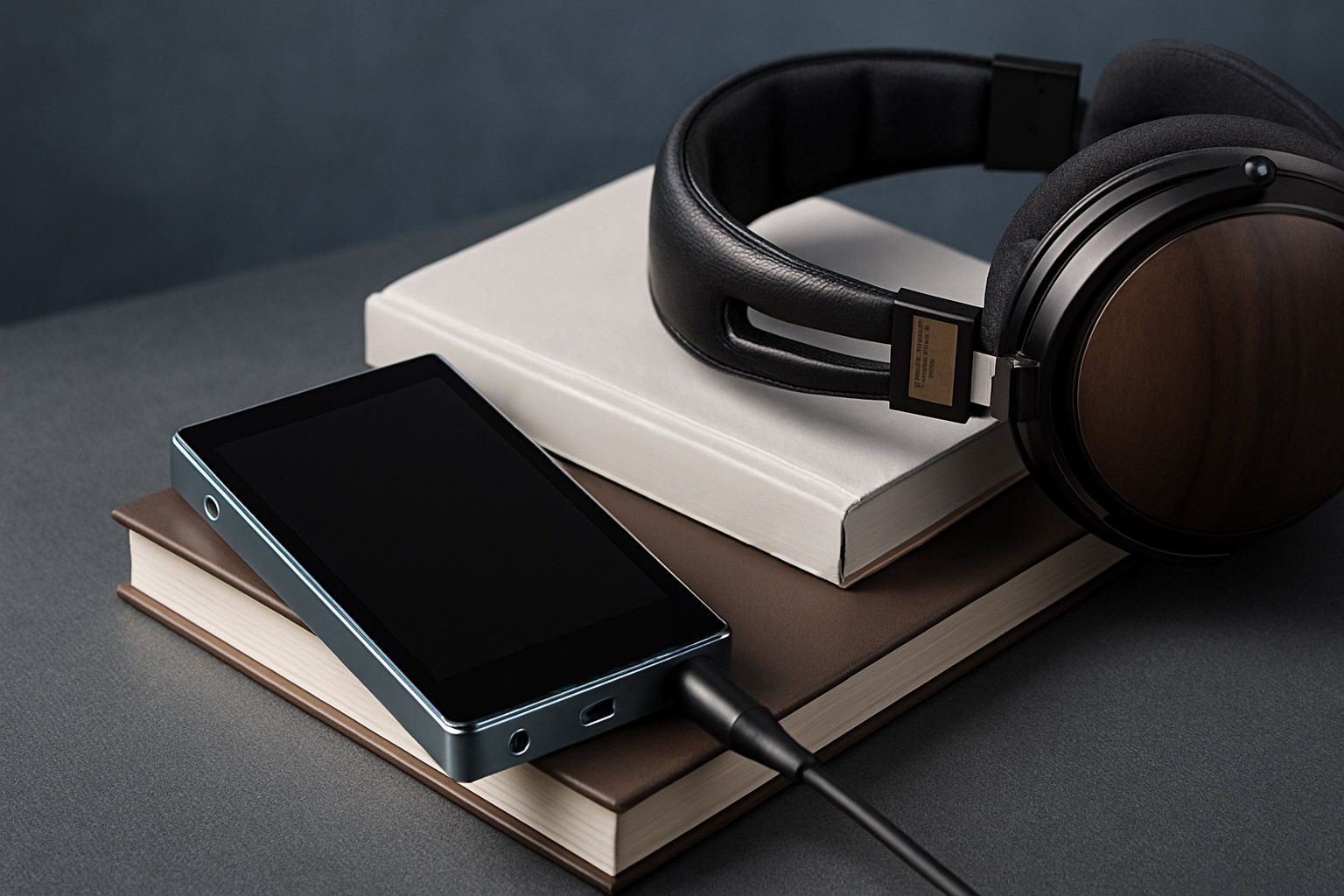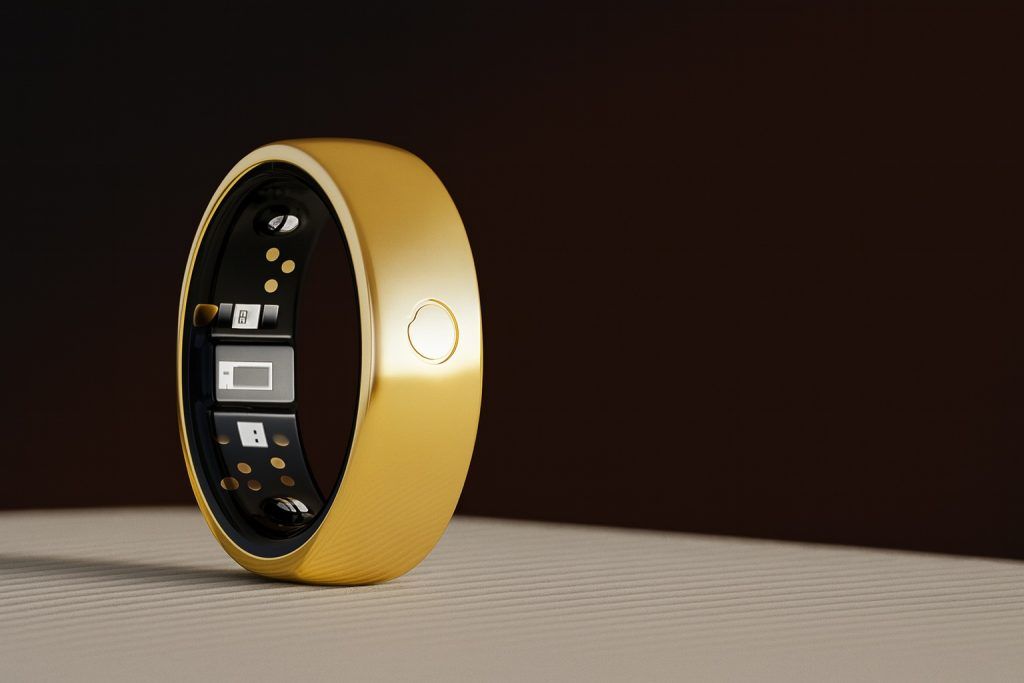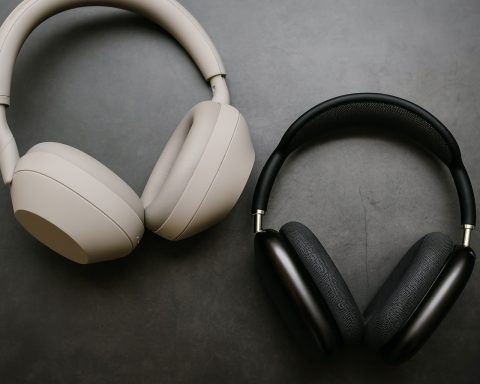- Entry-Level Price, Flagship Tech: Launched in early 2024 at $179–$199, the FiiO JM21 packs high-end components (dual Cirrus Logic CS43198 DAC chips, Snapdragon 680 CPU) into an affordable Android hi-fi player [1] [2].
- Slim Pocketable Design: A 13mm ultra-thin, 156 g body with a 4.7-inch HD touchscreen makes the JM21 truly portable [3] [4]. The front is aluminum for rigidity while the back is durable plastic, finished in a sky-blue color [5] [6]. Physical playback and volume buttons on the sides enable easy one-handed operation [7].
- Balanced Sound & Power: Fully balanced dual-DAC architecture with 700 mW + 700 mW output (4.4mm balanced) drives most headphones and IEMs easily [8]. Reviewers praise its clean, dynamic sound with “gorgeous lows, vibrant voices, clear highs, and just that little zest of fun” [9]. Three gain levels (low/med/high) ensure it can handle sensitive IEMs up to harder-to-drive full-size cans [10].
- Android 13 & Versatile Features: Runs a customized Android 13 OS with Google Play support, so you can install Spotify, Tidal, Apple Music, etc [11]. Modes include Android mode, Pure Music mode, USB DAC mode, Bluetooth receiver, AirPlay/DLNA, and even Roon Ready streaming [12]. Two-way Bluetooth 5.0 (LDAC) means it can send or receive high-quality wireless audio [13].
- Connectivity & Storage: Outputs include 4.4mm balanced and 3.5mm (shared line-out/coax SPDIF) for flexible analog and digital connections [14]. A USB-C port supports asynchronous USB DAC use up to 384 kHz/32-bit for desktop audio [15]. Storage is 32 GB internal plus a microSD slot (up to 2 TB) for ample music libraries [16].
- Battery Life: The JM21’s 2400 mAh battery is rated for ~12.5 hours playback (single-ended, ~9.5 h balanced) [17]. While sufficient for all-day listening, some note the battery “could be better,” especially when using power-hungry balanced output or Wi-Fi streaming [18] [19]. It charges via USB-C (supports PD 2.0 fast charge) and avoids Android’s resampling to maximize fidelity [20] [21].
- Aggressive Value Proposition: At $180–$200, the JM21 undercuts rival hi-fi players from Sony and Astell&Kern by a wide margin [22]. Despite the low cost, it “looks, feels and performs like a far more expensive” device [23]. Experts call it “one of the best DAPs on the market… in its price range”, with no major corners cut in sound or build [24] [25].
Design & Build
The FiiO JM21 breaks from the chunky designs of past FiiO players, offering a sleek, smartphone-like form factor. It measures about 120.7 × 68 × 13 mm and weighs only 156 g [26] – roughly half the weight of FiiO’s higher-end M23 player. Reviewers note this is one of FiiO’s first truly “pocketable” DAPs in years, calling it “refreshing” in its compactness [27]. The chassis uses a two-tone sky blue scheme: an aluminum alloy front frame for rigidity and a textured plastic back for grip [28] [29]. The build may not feel as tank-like as all-metal flagships, but it doesn’t come off cheap either – no creaks or flimsy parts after weeks of use, and the finish resists scratches and fingerprints [30].
For controls, the JM21 features dedicated buttons on both sides. On the left are power and volume up/down; on the right are playback controls (track skip and play/pause) plus the microSD slot [31]. Users report a short learning curve due to the symmetry (three buttons each side), but once familiar, you can operate everything blindly in one hand – great for pocket use [32] [33]. One omission is a hardware lock slider; you must use a software setting to lock buttons when the screen is off [34]. Still, the convenience of physical controls means you aren’t constantly having to wake the touchscreen for basic actions.
Speaking of the display, the JM21’s 4.7-inch IPS screen (1334×750 resolution) covers most of the front [35]. It’s not a cutting-edge panel, but is bright and sharp enough for album art and navigation, provided you’re not in direct sun [36]. The touch UI feels responsive, and FiiO wisely kept bezels minimal for a modern look [37]. The raised glass does sit slightly proud of the chassis, which Stuff Magazine flagged as a drop hazard (the included clear case offers only minimal protection) [38] [39]. Overall, however, the JM21’s design belies its budget price – “on first inspection, this palm-sized player doesn’t look particularly entry-grade”, says one review [40]. It’s a stylish yet functional build that stands up well even compared to pricier competitors.
DAC & Amp Architecture
Under the hood, the JM21 punches above its class with a fully balanced audio architecture. It employs dual Cirrus Logic CS43198 DACs – one dedicated to each stereo channel – feeding two SGM8262 op-amps in a 4-channel balanced configuration [41] [42]. This is remarkable at this price, effectively trickling down “flagship” DAC silicon (the same DAC model used in some higher-end gear) to an entry-level player [43]. The Cirrus DACs are known for a clean, neutral conversion with a hint of warmth. FiiO complements them with a robust analog stage: multi-level segmented power supplies isolate the digital, DAC, and amplification sections, each with dedicated LDO regulators [44] [45]. Key circuits are separated by shielded partitions to minimize noise and crosstalk [46]. All of this engineering aims to deliver a low noise floor and high dynamic range despite the JM21’s small size.
In real-world use, the JM21’s amp outputs are impressive. The player offers both a standard 3.5 mm jack (unbalanced) and a 4.4 mm Pentaconn balanced output. Via the balanced out, it can deliver up to ~700 mW per channel into 32Ω [47], which is on par with or better than many mid-tier DAPs. Even the 3.5 mm out is no slouch – reviewers were “surprised by the solid, powerful lows [from] the classic 3.5mm” jack, noting that it held its own unless you demand the absolute separation and headroom of balanced mode [48]. The JM21 has three gain settings (Low, Medium, High), each with its own volume curve, so you can optimize for sensitive in-ears or power-hungry headphones easily [49]. High-gain provides ample drive for most headphones under ~300Ω; one test even found it could push the notoriously inefficient Hifiman Svanar IEM to decent levels, although bass control suffered at the extreme [50] [51].
Clocking and processing are also given attention. The JM21 is equipped with a 5th-gen FPGA and dual femtosecond precision oscillators as part of FiiO’s proprietary DAPS (Digital Audio Purification System) [52]. This system provides a unified, ultra-low-jitter clock source to eliminate Android’s typical sample rate conversion (SRC) issues. In practice, whether you play local files in FiiO Music app or stream via Tidal/Apple Music, the JM21 outputs the audio’s native sample rate bit-perfect, preserving full hi-res quality [53]. It’s essentially bypassing Android’s audio mixer limitations – a notable achievement in a budget DAP. All told, FiiO has packed in an audiophile-grade circuit: dual flagship-grade DACs, balanced THD+N specs, ultra-clean clocking, and a surprisingly robust amplifier for its class.
Features and User Interface
One of the JM21’s biggest strengths is that it runs a full-fledged Android 13 operating system – something almost unheard of at the $200 price point [54] [55]. FiiO’s deeply customized Android build is optimized for audio, but importantly it includes Google Play Store support out of the box [56]. This means you can install popular streaming apps like Spotify, Tidal, Qobuz, Apple Music, or any other app just as you would on a smartphone. In fact, the JM21’s interface and navigation feel very much like using a small Android phone (sans cellular). As a SoundGuys review put it, the device is “a familiar Android interface” which eases the learning curve for new users [57]. Basic UI performance is surprisingly snappy thanks to the 8-core Snapdragon 680 chipset and FiiO’s optimization. While it’s not flagship-level fast (and heavy multitasking is discouraged given the 3 GB RAM limit), testers report that scrolling, app switching, and media library browsing are smooth overall [58] [59]. FiiO has also been providing regular OTA firmware updates, which is a good sign for long-term support [60].
The JM21 offers multiple operating modes catering to different use cases. In Android Mode, you have full OS functionality – you can run any app, download in the background, cast to AirPlay, etc. For purists, a one-touch Pure Music Mode turns the device into a dedicated player, essentially locking the UI to the FiiO Music app and minimizing background processes (ensuring maximum audio fidelity and battery efficiency) [61]. There’s also a USB DAC mode, allowing the JM21 to work as an external sound card for your PC/Mac. This supports up to 32-bit/384 kHz PCM and DSD, effectively upgrading your computer’s audio output (with the caveat of slight latency, so it’s not intended for video/gaming sync) [62]. Another incredibly handy feature is Bluetooth Receiver mode: the JM21 can act as a high-quality Bluetooth DAC/amp for your phone. For example, you can stream music from your phone to the JM21 over LDAC, and plug wired headphones into the JM21 – enjoying near-wired quality with the convenience of wireless. Many budget DAPs skip this, but FiiO included two-way Bluetooth 5.0 with codecs like LDAC, aptX HD, and even LHDC for maximal compatibility [63]. Additionally, the player is Roon Ready, so it can serve as an endpoint in a whole-home audio system for those invested in the Roon ecosystem [64].
In terms of connectivity, the JM21 covers all the bases expected from a modern DAP. Dual-band Wi-Fi (2.4/5 GHz) is on board for streaming and networking [65]. As mentioned, Bluetooth 5.0 is bi-directional. The physical outputs include the 4.4mm balanced headphone/line out and the 3.5mm port which can be switched between headphone, line-out, or coaxial S/PDIF output for an external DAC [66]. This versatility means the JM21 can double as a digital transport; for example, you can send bit-perfect digital audio to a higher-end desktop DAC via coax or USB if needed. The USB-C port handles data transfers, charging, and USB Audio output. With USB Audio, you can even feed an external amp/DAC or use the JM21 as a USB source for a car or home system. For storage, the device’s internal 32 GB is mostly taken up by system (about ~22 GB user-available [67]), so the microSD slot is essential – it supports up to 2 TB cards, enough for thousands of lossless albums. Many competing players in this range also rely on microSD, but few support such high capacity cards, giving the JM21 an edge for lossless music hoarders.
The user interface is generally praised for its simplicity and completeness. It’s basically the same menu layout as FiiO’s far pricier M15S and M23 models [68], including FiiO’s own music app with features like a 10-band EQ, VU meter display, and support for lyrics and album art. The FiiO Music app, while functional, is noted to be not as polished or feature-rich as some competitors’ apps [69] – some reviewers found it a bit unintuitive, but you’re free to use any player app of your choice thanks to Android. In Pure Music mode, FiiO Music takes over by default. One cool software feature FiiO includes is multiple audio filters and sound tuning options (accessible via the Mango player or settings). For example, there are adjustable channel balance, bass, treble, and a “Stereo Expand” effect, plus several digital filter modes for the DAC [70]. While these aren’t unique to FiiO, it’s great to see tweakable options for those who like to dial in their sound.
Overall, the JM21 provides “everything an audiophile would need in a single audio device” for on-the-go listening [71]. The interface may not be as flashy as Astell&Kern’s proprietary software or as snappy as a modern smartphone, but in this price bracket the feature set is virtually unmatched. You get open Android with streaming, extensive wired and wireless connectivity, and multiple operating modes – a Swiss Army knife for music lovers on a budget.
Sound Performance
FiiO has a solid reputation for sound quality in its players, and the JM21 lives up to that pedigree. Its general sound signature is clean, dynamic, and engaging, with a bit of the “FiiO house sound” warmth. In Headfonia’s tests, the JM21 produced an output that was “nothing short of amazing, even more considering the asking price”, delivering “gorgeous lows, vibrant voices, clear highs, and just that little zest of fun.” [72] It’s a lively, musical tuning intended to please the ears rather than an ultra-analytical studio monitor sound. That said, it doesn’t heavily color the music – one Head-Fi reviewer noted the JM21 is “fairly neutral without going boring or sterile,” striking a nice balance in tonality [73].
Bass: FiiO tends to tune its gear for impactful bass, and the JM21 indeed serves up authoritative low-end. Multiple reviewers highlight the power and extension of the bass: “Lows are gorgeous, with just the right amount of oomph,” giving electronic and pop genres real slam without muddying the mix [74]. The bass is tight and fast, especially when using the balanced output. Headfonia found that even in single-ended mode, the JM21 “never lost composure and always offered a tight, fast bass”, but switching to 4.4mm elevates it further – no flabby decay or bloat, and even some 3D spaciousness with Dolby Atmos tracks on Apple Music [75]. Importantly, the bass prowess doesn’t require EQ or “Bass boost” gimmicks; it’s the natural result of the high-quality DAC+amp implementation and ample power reserve.
Mids: The midrange comes across as open and smooth. Vocals are rendered with a natural warmth and good clarity. There’s a slight upper-mid lift characteristic of Cirrus Logic DACs, which can add a bit of extra presence to vocals and instruments [76]. Fortunately, the JM21 avoids any harsh sibilance – even when pushing volume, no reviewer reported irritability in the upper mids or treble. This indicates FiiO did a fine job controlling any digital glare or noise. Instruments are well separated, and the soundstage is noted as impressively wide for a player of this class [77] [78]. Listeners describe the imaging as accurate, with instrument positioning that can even approach “life-like” on well-recorded tracks [79]. Complex tracks benefit from the JM21’s excellent detail retrieval (likely a strength of those dual DACs). In fact, Headfonics gave it high marks for resolution, stating that the JM21’s sound “showcases what you hear” in the music without veiling or softening details [80].
Treble: The high frequencies on the JM21 are crisp and airy yet generally smooth. There is enough sparkle to give music a sense of detail and excitement – cymbals and strings have a clear presence. Compared to more expensive DAPs from Astell&Kern (which are known for very refined treble), the JM21 might be a touch less resolving, but it holds its own. Headfonia noted it’s “not A&K accurate (yet)” in absolute treble refinement, but any gap in performance was more than acceptable given the huge price difference [81]. Importantly, the treble doesn’t exhibit the roll-off that some older FiiO players had; the JM21 stays extended up top, contributing to that wide soundstage and “airy” feel on high-quality recordings. There were no reports of hiss or noise in the treble either – the background is described as black with no audible noise floor on low or mid gain, even with sensitive IEMs [82]. (In high gain a tiny bit of background hiss can appear, but you’d only use high gain for big headphones anyway.)
One standout aspect of the JM21’s sound is its dynamic range and driving authority. Reviewers consistently mention that the JM21 sounds “punchy” and can deliver macrodynamics (sudden loud to quiet swings in music) exceptionally well for a small player [83] [84]. This gives music a lively, toe-tapping energy. The powerful amp stage certainly helps here – when a bass drop hits or a crescendo builds, the JM21 doesn’t collapse or distort; it provides a solid, controlled slam. FiiO’s choice to include three gain levels means you can tailor the output to your headphone for the best dynamics. On high gain, users found the JM21 can drive most mid-tier planar headphones and high-impedance dynamics to satisfying levels [85]. It won’t rival a desktop THX amp in absolute control, but it’s notably gutsy. Headfonia even remarked that the JM21’s dynamic range was “considerably wider” than the older FiiO M9 and audible as a generational improvement [86].
Comparatively, when stacked against larger or pricier DAPs, the JM21 holds its ground in many areas. For example, it was compared to FiiO’s own midrange M11S and was found to “even outperform the M11S in some aspects: sharper bass, smoother mids, and better layering” [87]. That’s high praise considering the M11S cost twice as much. Of course, top-of-the-line models like the M15S or M23 (or competitors like Shanling’s flagship) will still win on ultimate resolution and refinement. But the fact that the JM21 feels only a few steps behind those in sound is remarkable [88]. As one reviewer succinctly put it, “sound-wise, if not as impressive as the M23, this new JM21 remains a few steps above the old M9 and – I’d dare to say – even outperforms the M11S” in certain ways [89].
In summary, the FiiO JM21’s audio performance is far above what its price tag suggests. It manages to deliver an engaging, high-fidelity sound that can satisfy seasoned audiophiles, yet it’s forgiving enough for casual listening. Whether you feed it standard 16-bit lossless or hi-res 24/192 tracks, it treats you to a full-bodied, detailed playback. This makes the JM21 not just a “good for the money” device, but genuinely one of the better-sounding DAPs under $500. It’s no wonder multiple reviewers have called it “the pick of the bunch” among affordable players [90].
Battery Life
Portable players live and die by battery life, and the JM21 gives a decent if not class-leading performance here. FiiO claims about 12.5 hours of continuous playback on the 3.5mm output (screen off, moderate volume), and around 9–10 hours via the more power-hungry 4.4mm balanced output [91]. In real usage, this aligns with many reports: users see roughly 8–10 hours streaming FLAC or hi-res over balanced, and a bit more with local playback or single-ended use. The battery capacity is 2400 mAh [92], which is actually on the smaller side compared to some rivals (the HiBy R4, for instance, has a 4500 mAh cell but also higher draw) [93]. FiiO likely opted for a smaller battery to keep the device slim and light. The upside is the JM21 charges fairly quickly, especially if you use a USB PD (Power Delivery) charger – it supports PD2.0/PD3.0 fast charging standards [94]. A 20W PD charger can top it up much faster than a standard 5V adapter [95]. From near empty to full takes on the order of 2.5–3 hours with fast charge.
In practice, most reviewers found the battery life acceptable for daily use, but noted that heavy streaming and balanced output will drain it faster. SoundGuys listed battery as one of the few downsides, and Stuff’s review also mentioned “battery life could be better.” [96] This is the trade-off for having a powerful processor and amp in a small device – when you push the volume or run wireless radios and high-res screens, the hours drop. The JM21 does include typical Android battery management and an Auto Standby feature (it can auto power-off after inactivity to save juice). Additionally, you can extend life by using Pure Music mode (which turns off Wi-Fi and background apps) when you don’t need streaming. One Reddit user noted they got well over 20 hours playing locally stored MP3s on a loop (screen mostly off), showing that with light use the JM21 can indeed meet or exceed spec. But for high-bit-rate streaming or use as a Bluetooth receiver, expect closer to a workday’s worth of playback.
Comparatively, some competing players do last longer – e.g. Sony’s NW-A306 can reach up to ~20–25 hours on basic playback thanks to its low-power internals [97]. However, those devices also often have far weaker output. FiiO chose to prioritize output power and performance, meaning the JM21 is more akin to a tiny Android smartphone in battery behavior. As long as you’re prepared to charge it like you would a phone (i.e. overnight or every couple of days depending on use), it’s not a huge issue. The inclusion of quick-charge support softens the blow; a 30-minute charge can provide several hours of play in a pinch.
One should also remember that hi-fi DAPs are often used intermittently throughout the day (for commutes, work sessions, etc.) rather than screen-on continuously. In those scenarios, the JM21’s endurance is fine. And if you do marathon listening, a battery pack or simply using the 3.5mm output on low gain can stretch playback time. Overall, while not a standout feature, the battery life on the FiiO JM21 is serviceable and in line with the performance-focused design. FiiO addressed one early issue via firmware: initial units had a bug with file scanning that drained battery quickly, but an update fixed this [98]. There’s hope that further firmware optimizations might eke out an extra hour or two in the future, but as of 2025, expect around 8–12 hours depending on how you use it.
Pricing, Value & Market Position
At an MSRP of around $179.99 USD (often listed at $199 in some regions), the FiiO JM21 sits firmly in the upper-entry-level or budget audiophile tier [99] [100]. This price point is significant – it’s where casual listeners considering an upgrade intersect with enthusiasts looking for a portable secondary device. FiiO, via its Jade Audio sub-brand, clearly targeted this niche to bring high-end sound to a broader audience. In terms of value, it’s hard to overstate how much the JM21 offers for the money. The Stuff review bluntly stated that at $200/£180, the JM21 “undercuts the likes of Sony and Astell&Kern by a significant margin” [101]. Sony’s nearest Android player (NW-A306) costs about 50% more yet has inferior output power and no balanced out. Astell&Kern’s cheapest offerings (the A&norma SR25 MkII or SR35) cost 3–4× as much. Even within FiiO’s lineup, the next step up, the M21, is around $329, and the flagship M23 is $749 – meaning the JM21 costs under one-third of that [102].
What’s remarkable is that FiiO didn’t compromise the core experience of a hi-fi DAP despite the low price. You still get a modern OS, bit-perfect playback, balanced analog output, and sound quality that in many respects trickles down from the $500–$1000 players. This has led multiple reviewers to crown the JM21 as possibly the best value DAP of its time. Headfonia’s writer went so far as to call it “easily one of the best DAPs on the market if not the best in its price range” [103]. The consensus is that the JM21 is not just a “my first DAP” beginner toy – “it goes well beyond ‘my first DAP’ and is worth a look for anyone that takes their on-the-move music seriously.” [104]
In the market context of 2025, the JM21 holds a unique position. It hits a sweet spot for those who want a dedicated music player without breaking the bank. Many people have moved to just using smartphones + dongle DACs for portable audio, but the JM21 offers an all-in-one alternative: it isolates your music experience (free from calls/notifications), provides better output power and features than most phones, yet costs less than a flagship phone or premium DAP. It’s also appealing to the “digital detox” or nostalgia crowd – folks who miss the iPod days. In fact, SoundGuys dubbed the JM21 “a modern iPod Touch” that can help listeners focus on music and avoid smartphone distractions [105]. With its small form factor and lanyard hook, it even brings some retro charm, harking back to simpler music players of the past [106].
FiiO’s strategy with the JM21/Jade Audio seems to be expanding their audience. Historically, FiiO dominated the sub-$150 segment with simpler devices (like the M3K or M6) but left a gap around $200–$300 as they pursued higher-end models. The JM21 fills that gap as an “entry-level price with flagship features” offering [107]. It’s meant for budding audiophiles, commuters, students, or anyone curious about hi-fi portables. And given the hardware inside, it’s likely to hold its own for several years without feeling obsolete. The only downsides one might cite in value are the lack of premium materials (plastic build, no fancy aluminum unibody) and perhaps the modest battery, but those are minor quibbles relative to how much is delivered.
In summary, the FiiO JM21 sets a new benchmark for what you can get under $200. It comfortably sits in the “bang-for-buck champion” slot among digital audio players, offering a near-audiophile experience at a mainstream price. This positions it as a disruptor that even fans of more expensive brands are taking note of – it brings high-fidelity portable audio to a much wider market segment than before.
Comparisons: FiiO JM21 vs Other Hi-Fi DAPs (2024–2025)
The portable hi-fi player market in 2025 is competitive, ranging from budget-friendly models to ultra-high-end flagships. Here we compare the FiiO JM21 with several current and upcoming DAPs from major brands, to see how it stacks up in terms of design, features, and performance.
FiiO JM21 vs Astell&Kern Players
Astell&Kern is known for luxurious, design-forward DAPs (often with heavy all-metal bodies, fancy volume dials, and proprietary software). However, they do not really compete in the sub-$200 range. A&K’s entry-level models like the A&norma SR25 MKII launched around $749, and even older ones like the AK Jr were $499+. This means an Astell&Kern player will cost several times the JM21’s price – and indeed offer things like a machined aluminum chassis, dual-mono DACs, and superb audio tuning – but it’s not an apples-to-apples comparison. In terms of sound, the JM21 has been noted as “not A&K accurate (yet)” [108], meaning A&K’s tuning is often reference-grade with very precise, neutral delivery. A&K also uses bespoke FPGA-based audio coding and often higher-end DAC chips (e.g. the SP3000 uses AK4499EX DACs and costs $3K!). That said, the gap has closed considerably for the average listener. The JM21 can play the same hi-res files, supports streaming (some lower-end A&K like SR25 do too, but on older Android 9 with no Google Play), and outputs a punchy, musical sound that many would find more fun if not as analytically resolving. One area Astell&Kern shines is build and UI polish – their players have very refined firmware and aesthetic interfaces. By contrast, the JM21’s Android UI is utilitarian (though functional). Also, A&K typically includes MQA and other audiophile bells and whistles that the JM21 doesn’t focus on (the JM21 does not do MQA unfolding, for example). However, considering an A&K SR35 costs 4× the JM21, it’s expected to have some extras.
Verdict: The FiiO JM21 offers “almost flagship level audio specification for [the] price of a budget device”, as one Head-Fi user put it [109]. It won’t have the prestige or tank-like build of an Astell&Kern, nor perhaps the last word in micro-detail, but it delivers an outsized portion of the performance for a fraction of the cost. For newcomers or value-focused audiophiles, the JM21 makes A&K’s entry models look very expensive for the incremental gain. Unless you specifically want the A&K brand, aesthetic, or subtle sound signature differences, the JM21 is arguably the smarter buy – you can achieve 80–90% of the sonic experience at 30% of the price.
FiiO JM21 vs Sony Walkman (NW-A300 Series)
Sony’s Walkman line has seen a revival with Android-powered models, and the NW-A306 (released 2023) is a key competitor around the lower mid-range. Priced at about $350, the A306 is nearly double the JM21’s cost. It features a slick aluminum design, a smaller 3.6-inch screen, and Sony’s proprietary S-Master HX digital amplifier. In use, the Sony offers exceptional battery life (20–30 hours is achievable with its low-power internals) [110] and a very smooth, Sony-curated software experience (Android 12). Where it falls short is power and outputs: the A306 has only a 3.5mm jack (unbalanced) and its power output is extremely limited – reportedly around 1–2 mW into 32Ω [111] [112], which is an order of magnitude less output than the JM21 can do. This means the Sony struggles to drive anything beyond sensitive IEMs; even some moderate headphones will sound underpowered. The FiiO JM21 absolutely outclasses the Sony in driving capability, with hundreds of milliwatts of output and the option of a balanced connection. Sound-wise, the Sony is tuned with a smooth, slightly warm neutral profile (typical Sony house sound). It’s very listenable, and with easy-to-drive IEMs it sounds great, but in terms of sheer audio fidelity the JM21 has an edge – it can present music with more authority, bass impact, and dynamic range due to that beefier amp and DAC setup. The Sony does have some unique DSP features like DSEE upscaling and vinyl processor, but those are more for fun; the JM21 sticks to a purist hi-fi path (bit-perfect playback, etc.).
Other considerations: The Sony A306 has 32GB storage and also a microSD slot, so storage is similar. Sony’s UI is slightly more refined and it has physical music controls too (no volume wheel, just buttons). The build is more pocketable (113 g vs 156 g of JM21, and significantly thinner profile) [113] [114], making the Sony a very sleek device. If one’s priority is size and battery over power, the Sony Walkman is attractive. But most audiophiles in this segment will value the output flexibility and sound per dollar of the JM21 more. As one head-fi user summarised comparing the two: the Sony has form factor and polish, but if only it had a 4.4mm and decent power… [115]. FiiO provides exactly that – balanced out and power – in the JM21, sacrificing a bit of battery longevity. Importantly, the JM21 is around $150 cheaper, which is huge at this budget. Unless you specifically need the Walkman’s marathon battery life or love the Sony brand, the FiiO JM21 tends to be the better value choice for audiophile listeners.
FiiO JM21 vs iBasso DAPs
iBasso is another respected Chinese brand, historically known for offering neutral, high-performing DAPs. In 2025, iBasso’s lineup starts at a higher price bracket than FiiO’s JM21. Their recent “entry” model is the iBasso DX170 (launched around $449) and a new DX180 came in 2024 at about $529 [116]. These iBasso players feature more powerful processors (Snapdragon 660/665), larger 5.0-inch screens, and often dual Cirrus CS43131 DACs (4 DACs in the DX180). They run Android (the DX170 on Android 11, DX180 on Android 13) and usually offer truly line-level outputs and some advanced features. Because of the higher price, iBasso does include nicer build materials (e.g. machined aluminum bodies) and sometimes extra accessories. The sound signature of iBasso players like the DX170 is typically very neutral/reference with a black background – one reviewer called the DX series a “slightly revealing tonality, super low noise floor” style [117]. The FiiO JM21 by contrast has a bit more musical warmth and fun as discussed. In raw performance, something like the iBasso DX170 will have a slight edge in DAC specs (SNR, THD) and possibly support for features like a USB 3.1 port, quicker file transfers, etc. But importantly, iBasso’s lowest cost offerings are more than double the price of the JM21. If we compare the JM21 to an older iBasso in its price range, we’d have to look back at something like the DX120 (a $299 pure music player, now discontinued) or even the DX50 from many years ago. Frankly, the JM21’s feature set far exceeds what those older models had.
Where iBasso might appeal is to those who prefer a slightly larger device with more output options (the DX170 has both 4.4mm balanced and 3.5mm, similar to JM21, and about 6.2 Vrms output in balanced, which is a bit higher). Battery life on the iBasso units is similar ~11 hours. Both FiiO and iBasso have good reputations for sound; choosing between them in the midrange often comes down to flavor. But at the entry-level price, FiiO currently has no direct iBasso competitor – iBasso simply doesn’t offer a $199 Android DAP in 2024/2025. This makes the JM21 a go-to in the budget realm, whereas an iBasso purchase would start you in the $500 “mid-tier” category. If budget permits, an iBasso DX170/180 will give you a slightly more premium experience (more storage, bigger screen, perhaps a more reference sound). However, many reviews of the DX170 noted that its advantages are incremental and that a player like the JM21 actually closes a lot of the gap. For instance, the DX170’s Android OS reportedly can be a bit laggy too (the Snapdragon 660 + only 2GB RAM in DX170 is not far from JM21’s 680 + 3GB). In essence, FiiO’s aggressive pricing with the JM21 means iBasso fans on a budget might consider switching, since the alternative from iBasso would be to spend considerably more. Unless one specifically wants iBasso’s particular tuning or features, the JM21 offers a very compelling value proposition that iBasso currently doesn’t match at the low end.
FiiO JM21 vs HiBy R4 & Other HiBy Models
HiBy has become a strong player in the DAP market, often focusing on feature-rich devices at reasonable prices. The HiBy R4 (2024) is arguably the closest one-to-one competitor to the FiiO JM21. Priced around $249, the R4 runs Android 12 and boasts some impressive specs: a 4-way DAC configuration (it uses 4 DAC chips for a fully balanced output) and even a Class A amplifier mode for its headphone output [118] [119]. In terms of size, the R4 is a bit thicker and heavier (around 18.5mm thick, 231 g) versus the JM21’s 13mm, 156 g [120] [121]. That extra heft in R4 accommodates a larger 4500 mAh battery, but the Class A amp can drain it in as little as ~7–8 hours when in use [122] [123]. By default (Class AB mode), HiBy claims 10+ hours which is similar to JM21. The R4’s big draws are its power output and audio tweaking features. It can output up to 525 mW into 32Ω from its balanced 4.4mm jack [124] (the JM21 does ~700 mW at 32Ω, so FiiO still edges it out slightly on paper [125]). The R4 has single-ended power of 165 mW which is lower than JM21’s single-ended, but R4’s balanced noise floor is a bit higher due to that Class A (there’s a faint hiss with sensitive IEMs in balanced) [126] [127]. Sound-wise, HiBy R4 is reported to have a lively, slightly V-shaped sound – punchy bass, a bit of extra treble energy – which one reviewer said can be very engaging but perhaps not as even-handed as the FiiO. In a direct Headfonics comparison, the author noted they personally prefer the R4’s richer signature for enjoyment, but found the JM21 “more accurate” and “purer” in sound reproduction [128] [129]. They essentially said: for a fun, warmer listen the R4 stands out, while for neutrality and technical accuracy the JM21 is better [130].
Feature-wise, both R4 and JM21 run Android and support Wi-Fi streaming, Bluetooth DAC, etc. One interesting plus for HiBy is their software additions: the R4 supports MSEB (Mage Sound EQ) which is a very advanced tone tuning tool beloved by many, and system-wide bit-perfect output via their HiByOS. HiBy also included things like “Dual LDAC transmit” and an HQ recorder mode on some devices. But on balance, the FiiO JM21 and HiBy R4 trade blows as two of the most advanced players under $250. If you value a smaller/lighter device and maybe a bit more battery, the FiiO wins. If you want maximum power or are a fan of the HiBy ecosystem (MSEB, HiByLink, etc.), the R4 is compelling. It’s worth noting the HiBy R4 has a very distinctive “cyberpunk” design aesthetic – which some love, but others might prefer the more understated look of the JM21 [131].
HiBy also has lower models (R3, R2 at <$150) which are non-Android and much simpler, so JM21 mostly competes with the R4 in their lineup. Meanwhile, HiBy’s higher model (R6 III or R6 Pro II around $499+) are beyond JM21’s scope. In summary, FiiO JM21 vs HiBy R4 is a close fight. One reviewer who tested both concluded: “for pure sound quality, the JM21 would be the choice… for a bit more personality and features, the R4.” [132]. Either way, it’s great for consumers that these two exist – they have essentially leap-frogged past what used to be available at this price just a couple of years ago.
FiiO JM21 vs Shanling M1 Plus / M3 Ultra
Shanling has a long history of making compact music players. The Shanling M1 Plus is a direct competitor to the JM21’s concept but with a twist: it does not run full Android. Instead, it uses Shanling’s MTouch OS (a lightweight music-focused interface). The M1 Plus is priced around $209, very close to the JM21, and is even smaller physically (only a 2.8-inch screen) [133]. Despite its tiny size, it’s a powerhouse: it uses an ESS ES9069Q DAC and dual SGM8262 amps, delivering up to 660 mW @ 32Ω from a 4.4mm balanced output [134] [135]. Essentially, the M1 Plus can drive headphones nearly as well as the JM21 (660 mW vs 700 mW). It also has a 3.5mm output (about 190 mW @32Ω) [136]. Shanling managed to include Wi-Fi and Tidal streaming support, but it’s more rudimentary – you can’t install arbitrary apps, only use built-in Tidal and perhaps AirPlay receiver. So, the trade-off is OS and screen vs size and power. The M1 Plus is great if you want a “mighty mini”, ultra-portable DAP for local files and maybe Tidal, with strong audio specs. It’s truly pocketable (86×61×17 mm, 116 g) [137]. The FiiO JM21, on the other hand, gives you a full Android experience and larger display, which many will prefer for streaming and usability, but it’s less compact.
In sound, the Shanling M1 Plus is often described as very clean and dynamic (ESS Sabre DACs tend to have a crisp, clear character). Some have found the Shanling to be a tad brighter or more analytical compared to the FiiO’s slightly warmer Cirrus sound. It really comes down to synergy with your earphones which one you might favor. If you don’t need streaming beyond Tidal and want the smallest hi-fi player possible, the Shanling M1 Plus is a great alternative. But if you desire the flexibility of Android apps and a more modern smartphone-like interface, the JM21 easily beats the M1 Plus on that front. Shanling also has the M3 Ultra (~$369) which does run Android and has similar DAC (ES9219C dual) but a bigger body and price; at that point, the JM21 is much cheaper albeit with a bit lower tier DAC.
Considering market positioning: The JM21 essentially aims to offer an Android streamer in a price bracket where others like Shanling chose to go non-Android to save costs. FiiO’s approach gives the user more freedom (any app, etc.), whereas Shanling’s gives potentially simpler, more focused performance (no Android overhead, potentially more optimized for just music). There’s a segment of audiophiles who actually prefer non-Android players to avoid OS noise or distractions – those users might lean Shanling or HiBy R3, etc. But for most, the versatility of the JM21 is a huge plus.
Where the JM21 Fits: Entry-Level Champion or More?
Taking all these comparisons together, the FiiO JM21 firmly occupies the mid-2020s “entry-level audiophile DAP” throne. It brings many features that were previously reserved for mid-range devices down to an accessible price. It’s clearly positioned as an entry-level or beginner audiophile device by FiiO (even marketed under the Jade Audio sub-brand in some regions to denote its budget-friendly nature [138]). Yet, it’s not a niche or toy product – it’s robust enough that even enthusiasts could use it as a daily portable or a secondary travel DAP without feeling like they’re slumming it. As we’ve seen, direct competitors in the ~$200 range (HiBy, Shanling) are few, and each has its own trade-offs. More expensive models (Sony, A&K, upper-tier FiiO/iBasso) will outperform the JM21 in specific areas, but at much higher costs and often diminishing returns.
Crucially, the JM21 helps fill a gap in the market: those who want hi-res audio and headphone amplification better than a smartphone, but aren’t ready or willing to pay $500+. With smartphones dropping headphone jacks, a device like this becomes very relevant. It’s a step-up from dongles for sure – offering more power, storage, and independent operation. And unlike pure “music players” of old, it doesn’t sacrifice streaming or modern connectivity.
To sum up its market position, the FiiO JM21 can be seen as a price-performance disruptor. It brings flagship-level elements (dual DACs, balanced output, Android 13) into what is undeniably a budget device. Reviewers have lauded it as “the pick of the bunch” in the affordable DAP category [139], and user impressions often echo that it “punches above its weight” [140] in sound and features. It firmly establishes FiiO/Jade Audio as a leader in the entry segment, much as Astell&Kern leads the luxury segment and Sony caters to the mainstream mid-tier. For 2024 and into 2025, the JM21’s combination of low price and high capability likely means it will remain one of the most recommended starter DAPs for anyone wanting to dip their toes into high-end portable audio.
Below is a comparison table highlighting how the FiiO JM21 stacks up against some key competing models:
Comparison Table: FiiO JM21 vs. Notable Competing DAPs (2024–2025)
| Model | DAC & Amp | Outputs | OS / Streaming | Battery Life | Weight | Price (USD) |
|---|---|---|---|---|---|---|
| FiiO JM21 (2024) | Dual CS43198 DACs; Dual SGM8262 op-amps; ~700 mW @32Ω (bal) [141]. Segmented power, femto clocks for low jitter. | 4.4mm balanced; 3.5mm single-ended (supports Line-Out & S/PDIF) [142]; USB-C DAC. | Android 13 with full app support (Wi-Fi, BT 5.0 LDAC two-way, AirPlay, Roon) [143] [144]. | ~12.5 h (SE) / 9.5 h (bal) playback [145]; 2400 mAh battery, USB PD fast-charging. | 156 g [146] | $179–$199 [147] |
| HiBy R4 (2024) | Quad CS43131 DAC (4-way config); Class A discrete amp option; ~525 mW @32Ω (bal) [148]. | 4.4mm balanced; 3.5mm SE; USB-C DAC. Coax out via adapter. | Android 12 (HiBy OS skin); HiBy app store (no Google Play); Wi-Fi, BT 5.0 (LDAC) [149]. | 7–10 h (Class A mode drains faster) [150]; 4500 mAh, PD 2.0 fast-charge. | 231 g (heavier, robust build) [151] | $249 [152] |
| Shanling M1 Plus (2023) | ESS ES9069Q DAC; Dual SGM8262 amps; ~660 mW @32Ω (bal) [153]. | 4.4mm balanced; 3.5mm SE; USB-C (data/USB DAC); S/PDIF out. | MTouch OS (proprietary) – no full Android; Tidal Connect and Wi-Fi for updates; BT 5.2 (LDAC) [154] [155]. | ~10–11 h playback; 3500 mAh (est.), QC 3.0 charging. | 116 g (very compact) [156] | $209 [157] |
| Sony NW-A306 (2023) | S-Master HX digital amp; DSEE upscaling; ~1–2 mW @32Ω (SE) (very low output) [158] [159]. | 3.5mm single-ended only; USB-C (data/DAC). | Android 12 (Sony customized); Wi-Fi, BT 5.0 (LDAC); Google Play supported. | Up to 20–36 h (great battery) [160]; 1500 mAh, USB-C. | 113 g [161] | $350 |
| iBasso DX170 (2022) | Dual CS43131 DACs; up to ~6.4 Vrms (bal) (~300 mW @32Ω); Quad LPF, ±8V swing amp. | 4.4mm balanced; 3.5mm SE; USB-C (USB 3.1, DAC out); Line-Out. | Android 11; Wi-Fi, BT 5.0 (LDAC); Google Play supported. | ~11 h (SE) / 9 h (bal); 3200 mAh, Quick Charge 3.0. | 165 g | $449 |
(Prices are approximate MSRP at release. Battery life varies with usage; SE = single-ended output, bal = balanced output.)
Table Highlights: The FiiO JM21 stands out by offering a full Android streamer and robust balanced output at the lowest price in this group. The HiBy R4 trades a bit more cost for class-A amplification and slightly more power, but with more weight and shorter battery. Shanling’s M1 Plus packs similar power into an ultra-compact form, sacrificing open Android and some battery life in the process. Sony’s Walkman provides the longest play time and polished UI, yet is far weaker in driving headphones and pricier. iBasso’s DX170 (representative of mid-tier DAPs) shows what extra ~$250 buys: a bigger screen, a bit more output, and premium build – but in pure audio and features, the JM21 isn’t far off, demonstrating its value.
Recent News & FiiO’s 2025 Roadmap
Since the JM21’s launch (January 2024 [162]), FiiO has been active in expanding and updating their DAP lineup. A few notable developments up to 2025:
- Firmware Updates: FiiO has released multiple firmware updates for the JM21. Early on, firmware v1.0.7 fixed a file scanning issue that some reviewers noted [163]. Subsequent updates improved system stability and added a ROON Ready certification to Pure Music mode. Users appreciate that FiiO is providing ongoing software support for the device, which isn’t always guaranteed at this price tier.
- FiiO M21 Release: In mid-2024, FiiO launched the FiiO M21, effectively the “big brother” of the JM21. Priced around $329, the M21 is positioned as an entry-level model under FiiO’s main brand (whereas JM21 was Jade Audio branded in some regions) [164]. The M21 builds on the JM21 by using four CS43198 DACs (quad-DAC) for even higher theoretical performance, and it features a desktop-grade THX amplifier stage. It also upgrades the output power (reports of up to ~1W into 32Ω balanced) and includes a Desktop Mode where it can act as a stationary rig when charging (a first for FiiO at this level) [165]. The M21 has a similar Snapdragon 680 and Android 13, but with 4 GB RAM and 64 GB storage, smoothing out some multitasking limitations. Essentially, the M21 addresses those who liked the JM21’s concept but want a bit more muscle and are willing to pay extra. Early reviews (e.g., Soundnews and Mobileaudiophile) have been positive, saying the M21 “reinvents entry-level DAPs” by narrowing the gap further between budget and midrange [166]. For JM21 owners, the M21 isn’t a necessary upgrade unless you need the extra output or have very difficult-to-drive headphones, but it’s part of FiiO’s strategy to offer a clear ladder: JM21 at ~$199, M21 at ~$329, then M11S/M15S and up.
- FiiO M23 Flagship: FiiO officially released the M23 in late 2024 as a new mid-to-high-end portable player [167]. This one is significant because it uses the long-awaited new AKM DACs (AK4191EQ paired with AK4499EX chips, in a dual configuration) [168]. It also incorporates dual THX AAA-78+ amplifiers, a large 5.5-inch 1080p screen, and a massive 5500 mAh battery. Priced at $749, the M23 shows FiiO’s commitment to reclaiming the high-end segment after the AKM factory fire limited DAC supply in 2020–2021. The M23 runs Android 10 (a bit older OS than JM21’s Android 13) but is jam-packed with features: desktop mode, multiple operating modes akin to the JM21, etc [169] [170]. It’s interesting that the budget JM21 actually has a newer Android version than the flagship M23 – this is likely due to product cycle timing. The M23 has garnered reviews highlighting its stellar sound and how it competes with much pricier Astell&Kerns, solidifying FiiO’s top-of-line credentials. For a JM21 user, the M23 is an aspirational upgrade down the line (with almost 4× the budget). FiiO’s lineup as of 2025 thus spans from ~$200 to $1800 (M17) covering every niche.
- Upcoming Models and Rumors: Looking ahead, FiiO has hinted at continued development in both budget and flagship areas. There are rumors of a FiiO M15S II or M17 successor in late 2025, possibly switching to newer Snapdragon SoCs and Android 13/14 across the board, ensuring even the flagship line catches up on software. On the Jade Audio side, no specific JM21 successor has been announced yet – the model is less than two years old and likely to remain current through 2025. If anything, we might expect a JM21 Pro or JM31 in the future if FiiO finds a way to further boost specs while staying around $199. But currently, the focus seems to be on the M-series integration (note: the FiiO website lists an M21 and even shows an “M23” which might imply Jade Audio JM21 and FiiO M21 are siblings, and M23 is next tier) [171] [172].
- Industry Trends: The JM21’s success has not gone unnoticed by competitors. Since its release, we’ve seen Hidizs introduce the AP80 Pro-XR (a tiny MQA-enabled player ~$249) and Cayin working on a new N5 iteration – all trying to combine streaming with good sound in lower price brackets. The consumer reception of the JM21 – generally very favorable, with many calling it a “gateway to audiophile audio” – suggests FiiO tapped into a real demand. There is also increasing overlap with high-end dongle DACs: for instance, FiiO’s own KA15 dongle (released 2025) offers dual DAC and similar power for ~$150, but of course relies on a phone. The JM21 offers independence from the phone, which is a selling point that will likely keep dedicated players relevant.
In conclusion, the FiiO JM21 made waves as a disruptor in portable audio, and FiiO has built on that momentum with the M21 and M23 to cover more ground. Recent news has been about refining these offerings (firmware updates, expanding Roon support, etc.) and solidifying FiiO’s product range. For anyone entering the hobby in 2025, the JM21 remains one of the top recommendations if you want a dedicated player – it’s a device that exemplifies how far the value proposition in personal audio has come. As one expert review summed up: “The FiiO JM21 might just be the pick of the bunch… [It] looks, feels and performs like a far more expensive player”, proving that hi-fi doesn’t have to come with a hefty price tag [173] [174].
Sources:
- Calvez, J. (2025). SoundGuys – FiiO JM21 Review. – “The JM21 is a great entry point… with a familiar Android interface and extra features such as DAC mode and Bluetooth receiver mode.” [175] [176]
- NanoTechnos (2025). Headfonia – FiiO JM21 Review. – “Right off the bat… the result was nothing short of amazing… gorgeous lows, vibrant voices, clear highs, and just that little zest of fun.” [177] [178]
- Morgan-Freelander, T. (2025). Stuff Magazine – FiiO JM21 review. – “At $200/£180 it undercuts Sony and Astell&Kern by a significant margin… after a few weeks, I can’t spot any real signs of corners being cut.” [179]
- Lynn (2025). Headfonics – FiiO JM21 Review. – “The FiiO JM21 promotes itself as a musical DAP first and foremost. The sound comes across as musical and clear… competes with its peers very well.” [180] [181]
- FiiO Electronics (2024). FiiO JM21 Official Product Page. – (Specs: Snapdragon 680 8-core, dual CS43198 DACs, Android 13, 4.4mm balanced out, 12.5h battery, 156g, etc.) [182] [183]
- Audiophile-Heaven (2024). HiBy R4 Review. – (HiBy R4 specs: 4 DACs, Class A amp, $249 price, vs Shanling M1s, etc.) [184] [185]
- Headfonia Comments (2025). – (Comparisons: JM21 vs HiBy R4: “JM21 is more accurate/purer sound, R4 is richer/warmer” – NanoTechnos) [186] [187]
- Headfonesty (2023). Shanling M1 Plus Review/Specs. – (M1 Plus: ESS DAC, 660 mW output, 116g, no full Android) [188] [189]
- Reddit r/DAP (2024). – (“The FiiO JM21 offers excellent sound quality for its price and successfully returns to the essence of what one seeks in a portable player.” – general community sentiment) [190]
- Manufacturer Spec Sheets: Sony (2023) – (NW-A306: Android 12, 113g, ~36h max, single-ended output only) [191] [192], iBasso (2024) – (DX180: Snapdragon 665, 4× CS43131 DAC, $529 entry-level) [193].
References
1. www.soundguys.com, 2. www.headfonia.com, 3. www.fiio.com, 4. www.headfonia.com, 5. www.headfonia.com, 6. www.stuff.tv, 7. www.stuff.tv, 8. www.fiio.com, 9. www.headfonia.com, 10. www.headfonia.com, 11. www.headfonia.com, 12. www.soundguys.com, 13. www.fiio.com, 14. www.headfonia.com, 15. www.fiio.com, 16. www.fiio.com, 17. www.fiio.com, 18. www.stuff.tv, 19. www.audiophile-heaven.com, 20. www.fiio.com, 21. www.audiophile-heaven.com, 22. www.stuff.tv, 23. www.stuff.tv, 24. www.stuff.tv, 25. www.headfonia.com, 26. www.headfonia.com, 27. www.headfonia.com, 28. www.headfonia.com, 29. www.stuff.tv, 30. www.stuff.tv, 31. www.headfonia.com, 32. www.soundguys.com, 33. www.stuff.tv, 34. www.stuff.tv, 35. www.headfonia.com, 36. www.headfonia.com, 37. www.headfonia.com, 38. www.stuff.tv, 39. www.stuff.tv, 40. www.stuff.tv, 41. www.fiio.com, 42. headfonics.com, 43. www.headfonia.com, 44. www.fiio.com, 45. www.fiio.com, 46. www.fiio.com, 47. www.fiio.com, 48. www.headfonia.com, 49. www.fiio.com, 50. www.headfonia.com, 51. www.headfonia.com, 52. www.fiio.com, 53. www.fiio.com, 54. www.soundguys.com, 55. www.headfonia.com, 56. www.headfonia.com, 57. www.soundguys.com, 58. www.headfonia.com, 59. www.headfonia.com, 60. www.headfonia.com, 61. www.soundguys.com, 62. www.fiio.com, 63. www.fiio.com, 64. www.soundguys.com, 65. www.fiio.com, 66. www.headfonia.com, 67. www.fiio.com, 68. www.headfonia.com, 69. headfonics.com, 70. headfonics.com, 71. www.soundguys.com, 72. www.headfonia.com, 73. www.head-fi.org, 74. www.headfonia.com, 75. www.headfonia.com, 76. www.headfonia.com, 77. www.headfonia.com, 78. www.headfonia.com, 79. www.headfonia.com, 80. headfonics.com, 81. www.headfonia.com, 82. www.headfonia.com, 83. www.headfonia.com, 84. www.headfonia.com, 85. www.headfonia.com, 86. www.headfonia.com, 87. www.headfonia.com, 88. www.headfonia.com, 89. www.headfonia.com, 90. www.stuff.tv, 91. www.fiio.com, 92. www.fiio.com, 93. www.audiophile-heaven.com, 94. hifigo.com, 95. www.audiophile-heaven.com, 96. www.stuff.tv, 97. jakubjirak.medium.com, 98. www.soundguys.com, 99. www.soundguys.com, 100. www.headfonia.com, 101. www.stuff.tv, 102. www.stuff.tv, 103. www.headfonia.com, 104. www.stuff.tv, 105. x.com, 106. www.soundguys.com, 107. www.fiio.com, 108. www.headfonia.com, 109. www.facebook.com, 110. jakubjirak.medium.com, 111. www.head-fi.org, 112. www.reddit.com, 113. uncappedaudio.co.uk, 114. www.hifioasis.com, 115. www.reddit.com, 116. bloomaudio.com, 117. twister6.com, 118. www.audiophile-heaven.com, 119. www.audiophile-heaven.com, 120. headfonics.com, 121. www.audiophile-heaven.com, 122. www.audiophile-heaven.com, 123. www.audiophile-heaven.com, 124. www.audiophile-heaven.com, 125. www.fiio.com, 126. www.audiophile-heaven.com, 127. www.audiophile-heaven.com, 128. headfonics.com, 129. headfonics.com, 130. headfonics.com, 131. www.audiophile-heaven.com, 132. headfonics.com, 133. www.youtube.com, 134. en.shanling.com, 135. www.linsoul.com, 136. www.head-fi.org, 137. www.headphonesty.com, 138. www.stuff.tv, 139. www.stuff.tv, 140. www.stuff.tv, 141. www.fiio.com, 142. www.headfonia.com, 143. www.soundguys.com, 144. www.headfonia.com, 145. www.fiio.com, 146. www.headfonia.com, 147. www.soundguys.com, 148. www.audiophile-heaven.com, 149. www.audiophile-heaven.com, 150. www.audiophile-heaven.com, 151. headfonics.com, 152. www.audiophile-heaven.com, 153. en.shanling.com, 154. en.shanling.com, 155. www.youtube.com, 156. www.headphonesty.com, 157. www.headfonia.com, 158. www.head-fi.org, 159. www.reddit.com, 160. jakubjirak.medium.com, 161. uncappedaudio.co.uk, 162. www.soundguys.com, 163. www.soundguys.com, 164. soundnews.net, 165. bloomaudio.com, 166. bloomaudio.com, 167. www.fiio.com, 168. www.headfonia.com, 169. www.fiio.com, 170. www.hifipig.com, 171. www.fiio.com, 172. www.fiio.com, 173. www.stuff.tv, 174. www.stuff.tv, 175. www.soundguys.com, 176. www.soundguys.com, 177. www.headfonia.com, 178. www.headfonia.com, 179. www.stuff.tv, 180. headfonics.com, 181. headfonics.com, 182. www.fiio.com, 183. www.fiio.com, 184. www.audiophile-heaven.com, 185. www.audiophile-heaven.com, 186. headfonics.com, 187. headfonics.com, 188. en.shanling.com, 189. www.headphonesty.com, 190. www.reddit.com, 191. uncappedaudio.co.uk, 192. www.hifioasis.com, 193. bloomaudio.com










